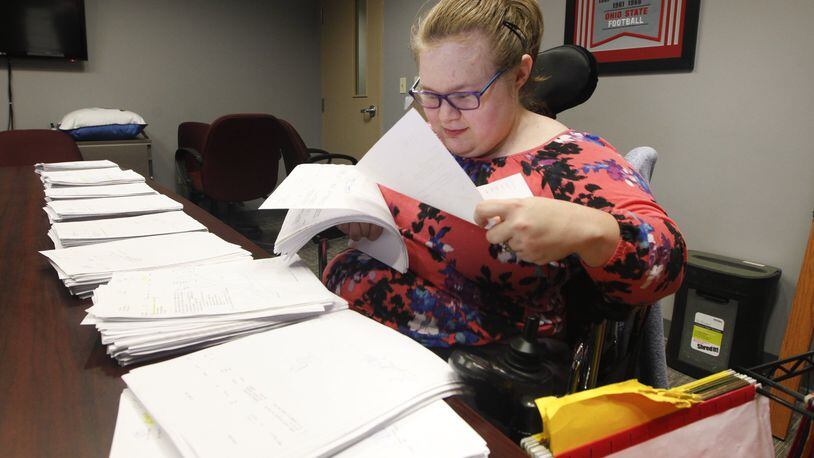RELATED: Local agencies get funds for mental health, substance abuse services
“Literally everyone is served through the public health district,” Kelley said. “So we know every citizen is touched.”
Services such as immunizations, restaurant inspections, and air and water quality monitoring are critical to every citizen’s well-being and health, he said.
A Human Services Levy has never been rejected by county voters.
Five main Montgomery County agencies receive the majority of the levy funding: the Board of Developmental Disabilities Services, Children Services, Alcohol, Drug Addiction and Mental Health Services (ADAMHS) board, Public Health – Dayton & Montgomery County and the Area Agency on Aging.
MORE: High staff turnover, burnout puts child welfare system in crisis
Montgomery County commissioners called for no additional funding this year, keeping the eight-year renewal levy at 6.03 mills, the current level. If voters pass this year’s renewal, known as Levy B, the owner of a home valued at $100,000 would continue to pay about $185 per year in property tax, according to the county auditor’s office.
Voters in November 2014 approved a measure for Levy A that added 1 mill. At 8.21 mills, Levy A generated about $74.2 million in 2017.
Access to resources
Without some county programs the levy funds, life would be “very difficult,” said Theresa Sauter, 29, who has multiple developmental disabilities.
“I wouldn’t be where I’m at right now,” said Sauter. “I wouldn’t have the equipment that I need to enhance my life.”
After a time in emergency housing – also supported by the levy – Sauter is now living semi-independently in a group home modified to accommodate her wheelchair and also assist her mobility with other alterations, including a track system.
RELATED: Disability rights topic of talk at WSU
“The levy helps these people enjoy a quality of life that most people take for granted,” said Nancy Banks, superintendent of the Board of Developmental Disabilities Services. “It gives adults with developmental disabilities opportunities to make choices about their lives, and provides access to resources that allow them to reside in the community … and become productive, contributing members of society by supporting their employment and volunteer efforts.
Sauter not only regularly bowls, volunteers at her church and joins field trips, she also goes to work. Sauter has been employed for nine years at Watson’s in Centerville as a clerical worker. She’s also a self-advocate for disability awareness, founding a local group, and speaks at a number of events.
“I tell them I’m a pretty active person in the community,” said Sauter, who lives in Centerville where she graduated from high school in 2007.
MORE: ‘Boot Camp’ helps disabled get job-ready
The levy campaign — Issue 3 on the Nov. 7 ballot — is endorsed by a number of organizations, including the Dayton Area Chamber of Commerce.
Phil Parker, president and CEO of the Dayton Chamber, said the levy is one of the most efficient ways to use taxpayer dollars to support those in greatest need.
“We trust and support the Human Services Levy Council as they set the priorities for our region on our behalf,” Parker said.
‘The need is everywhere’
Kelley said a majority of people the Montgomery County levy dollars assist live outside of Dayton.
“There are a lot of people who have this myth that everyone in need is part of the core population in the urban area, and that’s just not what our numbers tell us,” he said.
MORE: Dayton Children’s to add mental health wing
Sixty percent of 2016 services by ADAMHS went to clients outside the central Dayton district, according to ADAMHS records. The county’s suburbs accounted for a full 81 percent of services by Developmental Disabilities Services, 54 percent of Children Services clients, and 65 percent of services by Public Health - Dayton & Montgomery County.
“It’s not just in the core city of Dayton where the need is,” Kelley said. “The need is everywhere … It’s their neighbor. It’s their friend … It’s everywhere.”
Editor’s note: This story has been updated to reflect the amount of revenue the levy will generate as certified for the election ballot.
Primary agencies supported by Montgomery County Human Services Levy
ADAMHS Board
Oversees network of community-based alcohol, drug addiction and mental health services.
2016 clients: About 18,600
2017 budget: $39.7 million
Board of Developmental Disability Services
Responsible for primary lifelong services for children and adults with moderate, severe and profound mental retardation or other developmental disabilities.
2016 clients: About 7,500
2017 budget: $57.1 million
Children Services Division
Responsible for investigating reports of child abuse, neglect and dependency.
2016 clients: About 9,880 children in 3,570 families
About 650 children were in agency custody
2017 budget: $52.9 million
Public Health – Dayton & Montgomery County
Responsible for providing a variety of community health services from immunizations to environmental safety.
2016 clients: all county residents
2017 budget: $34.4 million
Frail Elderly Programs
Provides in-home, client-based services.
2016 clients: 1,690
2017 budget: $9.9 million
About the Author
